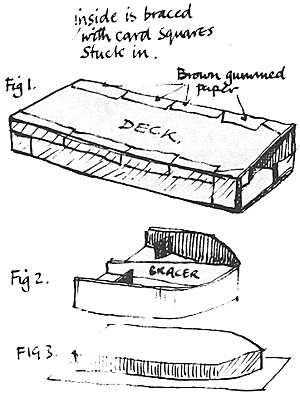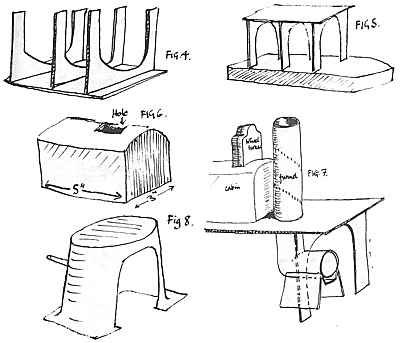 Making some items of equipment can be a way of saving money - to spend on more castings in the end probably. Fairly recently buildings and boats have been produced which are the epitome of good casting and modelling. VILLAGE GREEN, REDOUBT ENTERPRISES, and BATTLEMENTS all spring to mind. I haven't seen WARD'S FOUNDRY efforts but I hear they're good too. However, the drawback on all this artistry and precision is the price. If you can afford it, I urge you to go ahead and buy and keep these craftspeople in business, the hobby needs them. As a retired person things like food, warmth and mobility come high, and all have to be paid for - so-o-o- if you want a colonial steam boat and can't afford it, make one yourself. I did, and if I did, ANYONE can.
Making some items of equipment can be a way of saving money - to spend on more castings in the end probably. Fairly recently buildings and boats have been produced which are the epitome of good casting and modelling. VILLAGE GREEN, REDOUBT ENTERPRISES, and BATTLEMENTS all spring to mind. I haven't seen WARD'S FOUNDRY efforts but I hear they're good too. However, the drawback on all this artistry and precision is the price. If you can afford it, I urge you to go ahead and buy and keep these craftspeople in business, the hobby needs them. As a retired person things like food, warmth and mobility come high, and all have to be paid for - so-o-o- if you want a colonial steam boat and can't afford it, make one yourself. I did, and if I did, ANYONE can.
MATERIALS - Corrugated cardboard, off-cut wood, dicarded plastic pots, tubes. T'FIM" modelling material. The corrugated cardboard I got as grocery store discards.
EQUIPMENT - Craft knife, scissors, glue ("all-purpose" or woodworkers glue), steel rule and a cutting board (in y case an odd bit of hardboard). Pencil, modelling paints. Sticky brown paper (comes in a roll from stationers).
First find some references, pictures of the boat you wish to model (I have five of a seven volume set of "Battles of the Nineteenth Century" by Cassels and several pictures of steam boats can be seen in those). Libraries can find books for you and model and wargame magazines have pictures and drawings.
With my model, it was to be in 25m scale, but obviously you can make it in whatever scale you wish; one can make a pretty good guess at proportions. The basic waterline hull of mine was 15" long from stem to stern and four inches wide. I made a box section hull with corrugated card and a bow separately which I stuck ono All was held more secure by sticky brown paper - or gummed paper (tastes awful!). See figures 1.
The deck & hull sides were made in one piece, the edges being scored and then a base added when the bracers had stuck firm. All corner edges were re-inforced by gusted paper.
Tie bow was treated in the sane way but had a central long bracer for the stem. The sides were scored inside to help bend the hull into a bow shape. The bow was stuck to the hull and gum papered over. See figure 2.
 The whole hull was stuck onto a slightly larger base to strengthen and protect it. See Figure 3.
The whole hull was stuck onto a slightly larger base to strengthen and protect it. See Figure 3.
Next came the superstructure. Three "arches" of corrugated card-board were cut out, edged with gusted paper and all stuck onto a sheet of card 10" long X 4" wide. See Figure 4. When properly stuck, this was reversed and stuck to the hull. See Figure 5.
Then I made a simple hut-like edifice in card with a hole cut in it's roof. See figure 6. This was the upper cabin. Next a bit of light offcut-wood was used as the wheel-house. It fits into the hole in the upper cabin roof.
Next my "beachcombers box" of items - suitably washed - produced two bits of plastic pipe. A large one for the funnel and a right angled one for the furnace and boiler. Having cut, scored, bent and glued some more card to the boiler support, I stuck these three bits to the existing hull. See figure 7.
Next came a problem - what to do about quick firing gun shields. Unbeknownst to him, a well-known (in UK) German yoghurt supplier provided the answer. A yoghurt/fruit container was chipped off. The back of it cut out - the plastic it was made of cutting very easily. Reverse the corner container and there is one Q.F. gun shield complete with flanges allowing it to be stuck down to the upper deck. See Figure 8.
The gun barrel was provided by an odd watercolour paint brush protector tube stuck through a small hale in the shield. The block of "FIMO" was used to make up bales of "straw" and "sacks" to be stuck together to protect the engine and crew. The crew was supplied by REDOUBT ENTERPRISES who can also supply soldiers, sailors, screw guns & Nordenfeldts. Or if you don't want to do it the interesting way - a whole paddle steamer! Mine is a screw vessel but a contraption for a paddle wheel & gear in corrugated card could easily be made and placed at the rear to make the boat an older model.
All is painted with acrylic hobby paint, textures and details being painted on.
As my Nile steamer "HNS Crab" got crushed when we moved house, I call it "H?''S Catfish." Soley because I draw a colunn called FAT CAT.
Well, there you are, Have a go and see what transpires. I'm using 12 guage cartridge cases for funnels for ACW gunboats I'm making it now from slats of wood. Have fun!
(Editor's Note: Thanks for excellent article, David! LYZARD'S GRIN, PO Box 14522, Oklahoma City, OK, 73113, has a wide selection - very wide - of 25mm guns on cones for gunboats! Excellent pieces they are as well! For funnels, check out your cigar store! Some cigars are sold in plastic tubes and they work very well for funnels. LYZARD'S GRIN has at least one quick firing gun with shield on a cone and many core gums including Nordenfeldts! Clem Clenens gave me some real chain which I will be using on my VILLAGE GREEN gunboat which he found at second hand stores - jewelry type chains. You might also check out "plasticstruct" sections in your local train store - it comes in various thicknesses and could well be used for construction - especially the very thin type.).
Back to MWAN #67 Table of Contents
Back to MWAN List of Issues
Back to MagWeb Magazine List
© Copyright 1994 Hal Thinglum
This article appears in MagWeb.com (Magazine Web) on the Internet World Wide Web.
Other articles from military history and related magazines are available at http://www.magweb.com